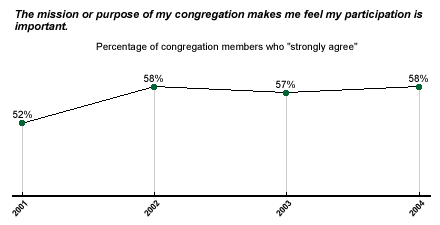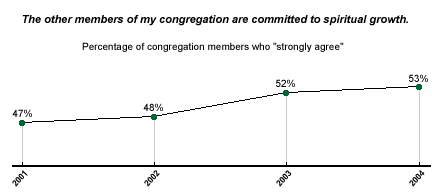Since the inception of ║┌┴¤═°'s index survey tracking engagement among members of U.S. faith communities, congregations have experienced a moderate increase in the percentage of "engaged" members, from 26% in 2001 to 32% in 2004 (see "Exploring the Rise in Congregational Engagement" in Related Items). This week, we continue our look at the specific components of the index that have improved over the past four years.
1. "As a member of my congregation, my opinions seem to count."
The percentage of congregation members who "strongly agree" with this statement (scoring the item with a "5" on a scale of 1 to 5) has slipped over the majority mark, from 47% to 53% in the past four years.

That's an encouraging trend, because communication is vital to the health of any congregation, regardless of its size. When members believe that decisions affecting them are being made without their input, they begin to feel insignificant or even irrelevant. This is a recipe for trouble in any organization, but especially in faith communities. People look to their congregations to help find meaning and purpose in their lives, as well as a sense of belonging. When members begin to think their opinions don't matter, they feel devalued -- and their sense of belonging plummets. Effective leaders find out what their members think, even if they don't always agree with or act on those opinions.
2. The mission or purpose of my congregation makes me feel my participation is important.
Members of faith communities want to feel as if they truly belong -- that they are not just names on the membership roll. They want a clear idea of the purpose of their congregation, and a sense that fellow congregation members share that purpose. The challenge for leaders is to connect the mission of the congregation with each member's personal life goals, so individuals can easily make connections between the congregation's overall values and their own.
In 2001, the percentage of members who strongly agreed that the mission of their congregation makes them feel their participation is important stood at 52%; that percentage was up to 58% in 2004.

3. The other members of my congregation are committed to spiritual growth.
In today's world, people are not looking for churches where the members look, act, and think just like they do, but they do expect all members to be committed to spiritual growth. That growth may take on different forms depending on the unique spiritual wiring of each individual. Some members may find growth through Bible study or prayer groups, others through teaching religious education classes, still others through "hands-on" mission projects. Whatever form it takes, members of faith communities want to see evidence of spiritual growth occurring in both themselves and their fellow members.
More than half (53%) of congregation members in the United States now strongly agree with this item, up from 47% in 2001.

Bottom Line
Spiritual leaders may be gratified by the fact that ║┌┴¤═°'s data suggest improvement in the conditions that lead to congregational engagement. By focusing attention on the things that make a real difference in the lives of their members, leaders can create not only healthier congregations, but also more spiritually mature individuals.
Next week, we will look at the four outcomes that are influenced by engagement: life satisfaction, inviting, serving, and giving.
The items of the SE25 are protected by copyright of The ║┌┴¤═° Organization, Princeton, NJ, 2001. All rights reserved.
*Results are based on telephone interviews with 1,000 adult members of a church, synagogue, or other religious faith community, aged 18 and older, and 500 nonmembers, conducted in October 2004. For results based on this sample, one can say with 95% confidence that the margin of sampling error is ±2.6 percentage points.
